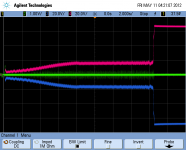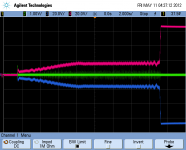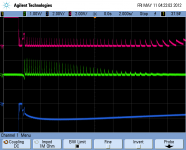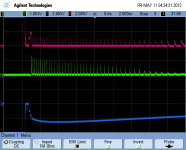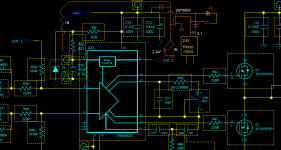One dps-600 supplies both voltage eg. +/-68V and 85V for lme (or other difference,that Owen advice)
yes, one dps-600 for one amp (independant of power)
Is possible VADJ (trim on board) +/-5% Vout (lme follow in proportion)
Great, than I'm definitely buying it. Just waiting to see if there will be GB or not (I hope it will
Great, than I'm definitely buying it. Just waiting to see if there will be GB or not (I hope it will)
yeah we will, should we start a list somewhere today? we have 2 options, see if we can arrange for the bulk purchase to be made, but still have the supplies sent out individually, or find a reputable (not new, it'll be a fair chunk of change) member of the GB in the EU to accept the package and redistribute them to the rest of us. the second one also complicates the tax/vat scenario, as we would be charged tax on all of them and then possibly a second lot of tax on delivery to the final owners. the second option also complicates ownership and support somewhat, as it could be said that person is the person who bought them.
excellent! have you run it higher than this by adjusting after start up? so we just need to work out a way to delay the connection to the amp, though that would also delay the loading of the PSU wouldnt it? so may not actually achieve what we set out to do.Hi Guys,
Just a quick heads up to say that I tested the DPS-600 with a 600mA bias current, and it did start up. It seemed to take a little longer than at 400mA, but it did work.
Regards,
Owen
is the linear regulator (headamp PSU) still used, or omitted when using these supplies?
Hi again, i'm back with a few new stupid questions...
I have read the last few posts a few times but there are a few things that i'm not completely following. I'm aiming for a bit over 100W in output power because i think that should be sufficient to drive any "conventional" speaker to reasonable volumes with some headroom. If i'm mistaken here please tell me asap so i won't find out the expensive way...
1. Would it be helpful to use some circuit to detect if the power cord is connected and when it disconnects draw the shutdown pin of the SMPS and the mute pin of the LME? Or do the noise go trough the rails so it's useless to mute the LME?
2. When you start the amplifiers is that without input signal? In that case what happens if there is music playing at startup (and shutdown)?
3. Do the DPS600 benefit from the PBTU-2? It is listed as a related product on the website but if i understood owen correctly it wasn't used for the DPS600 measurements does that mean it provides no significant improvement?
4. If i understood correctly AP2 you can easily lower the output voltage of the DPS600 without loosing any performance right? Say about +/-50V for the mosfet rails just to reduce the temperature of the amp.
So i think the DPS400 looks nice in terms of power and price but i'm a bit scared of the transients on startup and shutdown. I can accept 3-400mA of bias which seems to work nicely after the updates.
But if my estimate is correct the price difference between dps400 and dps600 is only around 50€ and in that case i can definitely consider the dps600 if that's where the group is heading.
In the end i'm still up for some SMPS, as least 2 maybe a third. I'm having problem to decide because active woofers seem to be a lot more common and then includes filters to set the breakfrequency in an easy way, and my main problem still stands because the dac only provides stereo output...
I have read the last few posts a few times but there are a few things that i'm not completely following. I'm aiming for a bit over 100W in output power because i think that should be sufficient to drive any "conventional" speaker to reasonable volumes with some headroom. If i'm mistaken here please tell me asap so i won't find out the expensive way...
1. Would it be helpful to use some circuit to detect if the power cord is connected and when it disconnects draw the shutdown pin of the SMPS and the mute pin of the LME? Or do the noise go trough the rails so it's useless to mute the LME?
2. When you start the amplifiers is that without input signal? In that case what happens if there is music playing at startup (and shutdown)?
3. Do the DPS600 benefit from the PBTU-2? It is listed as a related product on the website but if i understood owen correctly it wasn't used for the DPS600 measurements does that mean it provides no significant improvement?
4. If i understood correctly AP2 you can easily lower the output voltage of the DPS600 without loosing any performance right? Say about +/-50V for the mosfet rails just to reduce the temperature of the amp.
So i think the DPS400 looks nice in terms of power and price but i'm a bit scared of the transients on startup and shutdown. I can accept 3-400mA of bias which seems to work nicely after the updates.
But if my estimate is correct the price difference between dps400 and dps600 is only around 50€ and in that case i can definitely consider the dps600 if that's where the group is heading.
In the end i'm still up for some SMPS, as least 2 maybe a third. I'm having problem to decide because active woofers seem to be a lot more common and then includes filters to set the breakfrequency in an easy way, and my main problem still stands because the dac only provides stereo output...
the PBTU-2 is not used in any of the measurements and it is not used with the dps600, it is a stand alone linear supply, it would only make matters considerably worse if used in conjunction. we are already working on the shutdown behavior, for the 600 it doesnt matter a great deal as there is nothing to be scared of in the transients and I gather the 400 isnt as bad as it appears. do remember the output is scaled higher than the rails if you read the graphs properly. the start up behavior presents more of a challenge than the shutdown, but should be easy enough to solve regardless
we cannot set a multitude of different Vout levels for the supplies, particularly if we expect to take advantage of bulk pricing. the supplies are adjustable +/-5% from the voltage that comes factory set, no more. we should decide on 1 or 2 voltage options for each 400 and 600
I have no solution for your stereo dac issue, so you are still pursuing multiple channel output with only 2 channels?
we cannot set a multitude of different Vout levels for the supplies, particularly if we expect to take advantage of bulk pricing. the supplies are adjustable +/-5% from the voltage that comes factory set, no more. we should decide on 1 or 2 voltage options for each 400 and 600
I have no solution for your stereo dac issue, so you are still pursuing multiple channel output with only 2 channels?
Last edited:
I hope that Owen contact me fast. becouse:
DPS-600 have 1 output pin (optoiso) action=(low to gnd after startup is complete)
1 input pin (optoiso) action=(if close to gnd,smps break fast)
is possibile that someone can use this in good way.
----------------------------------------------
problem in startup/shuntdown, even scale is 1V, is apparent mistake.
i have sended email to Owen, just for understand action of mute in lme.
i think that mute switch off, while voltage pump at 20V.
after i ceck it, is possible as professional application, that amplifier is "enabling" from smps (after startup sequence, if all is ok)
now, exist many way for this, we find a simple..very simple.
if we see well measure at startup/ shuntdown, dps-600 not emit spike
-----
I mean,if Owen send me measure with mute fix on, then is simple. ruote same component used on mute, for obtain a treshold. eg. mute switch off when voltage =>30V. this solve all. amplifier is in mute condition while voltage is 20V, even i want adjust this time a 3-4 sec
DPS-600 have 1 output pin (optoiso) action=(low to gnd after startup is complete)
1 input pin (optoiso) action=(if close to gnd,smps break fast)
is possibile that someone can use this in good way.
----------------------------------------------
problem in startup/shuntdown, even scale is 1V, is apparent mistake.
i have sended email to Owen, just for understand action of mute in lme.
i think that mute switch off, while voltage pump at 20V.
after i ceck it, is possible as professional application, that amplifier is "enabling" from smps (after startup sequence, if all is ok)
now, exist many way for this, we find a simple..very simple.
if we see well measure at startup/ shuntdown, dps-600 not emit spike
-----
I mean,if Owen send me measure with mute fix on, then is simple. ruote same component used on mute, for obtain a treshold. eg. mute switch off when voltage =>30V. this solve all. amplifier is in mute condition while voltage is 20V, even i want adjust this time a 3-4 sec
Last edited:
Hi Guys,
Attached is the startup and shutdown plots for the DPS-600 at 600mA.
Startup takes 16 seconds from "plug in" to full rails.
I connected a Behringer Truth passive monitor to the output of the amp to see how the transients actually sound. On startup, there is absolutely no audible click, pop or anything else. The amp and PSU are dead quiet at startup with or without the LME muted.
On shutdown, I captured both with the LME muted and with it unmuted. Not surprisingly, it makes no difference between the two states since the off transients are being caused by the + rail of the supply pulsing on and off, which completely bypasses the amp through the output mosfets.
Based on the above, I can assure everyone that this is not an instability issue with the amplifier, and is definitely the supply. I can check tomorrow by measuring just the supply driving a 250 ohm resistive load, and I would imagine that I will see the same behaviour on the positive rail.
With the Behringer hooked up, these transients are audible, but not detrimental in any way. I could see it being a little obnoxious, but it won't damage anything.
Regards,
Owen
Attached is the startup and shutdown plots for the DPS-600 at 600mA.
Startup takes 16 seconds from "plug in" to full rails.
I connected a Behringer Truth passive monitor to the output of the amp to see how the transients actually sound. On startup, there is absolutely no audible click, pop or anything else. The amp and PSU are dead quiet at startup with or without the LME muted.
On shutdown, I captured both with the LME muted and with it unmuted. Not surprisingly, it makes no difference between the two states since the off transients are being caused by the + rail of the supply pulsing on and off, which completely bypasses the amp through the output mosfets.
Based on the above, I can assure everyone that this is not an instability issue with the amplifier, and is definitely the supply. I can check tomorrow by measuring just the supply driving a 250 ohm resistive load, and I would imagine that I will see the same behaviour on the positive rail.
With the Behringer hooked up, these transients are audible, but not detrimental in any way. I could see it being a little obnoxious, but it won't damage anything.
Regards,
Owen
Attachments
Thank Owen, just for be clare, my word "instability" I did not want to refer to the amplifier, but in the particular circumstance that was emerging. but you are right, positive rail contain pulse.
it is clear that we are in an extreme condition (startup lasts too long) then you must reduce that time to about 3 sec at 400mA.
Now i understand that "mute" not have action on driver, as enable /disable circuit.
it is clear that we are in an extreme condition (startup lasts too long) then you must reduce that time to about 3 sec at 400mA.
Now i understand that "mute" not have action on driver, as enable /disable circuit.
Chris (hochopeper), can we use xBEE to set the bias you think? start at 200ma and ramp to 600-650ma after 10 seconds?

Was wondering how long till you to asked! Need to have another look at the amp [I haven't looked at it in much detail yet and it has been months since I've read owen's manual or looked at the schematic] and what interface options we've got. I'm not confident the xbee is the right tool for that job, but I'll look into it.
VR5 just a straight forward 5k pot. suppose you could use an LDR and the xbee could control voltage through that, rather than expecting the xbee to supply a quiet bias supply. whatever we did it would mean using the xbee as a means to control the bias setting, not actually DO the bias setting.
I the like relay suggestion opc!
Since I didn't have time to read the schematic I was being a bit conservative because before saying 'yep we can do that with xbee' I want to be confident of worst case mode of failure say the xbee/controller didn't act as expected. If we're saying worst case is that bias remains at 200ma then that's not going to have qusp rocking around to my joint wanting answers if something does go awry!
Since I didn't have time to read the schematic I was being a bit conservative because before saying 'yep we can do that with xbee' I want to be confident of worst case mode of failure say the xbee/controller didn't act as expected. If we're saying worst case is that bias remains at 200ma then that's not going to have qusp rocking around to my joint wanting answers if something does go awry!
You could switch a relay between two different resistors, each fixed for a discrete bias level. Set one value for 200ma and the other for 600ma.
Regards,
Owen
yeah I thought that too, but wasnt sure if just going straight from 200->600 was advisable, or whether that action in itself would cause another transient. If thats all thats required thats dead easy, could even just have a switch (to control a relay), although I dont want that messing up my clean front panel lol
Last edited:
would it be better to have it so that 2 identical resistors were used, one in circuit all the time and another switched in in parallel? I presume lower resistance = higher current? this way there is never a time, no matter how short where there is an open circuit this way it could easily be 300 and 600ma, or calculate 200 and 600 easily enoughYou could switch a relay between two different resistors, each fixed for a discrete bias level. Set one value for 200ma and the other for 600ma.
Regards,
Owen
The way i understood it the PBTU-2 was used for the DPS400 measurements. And it is just a few large capacitors in the high power rail and two LME317/337 regulators + caps for the low power rail. There is a schematic in the datasheet.
Regarding the bias adjust, to add a switch resistor in parallel sounds like a better idea. The relay can either connect or disconnect the second resistor. But wouldn't a digitally adjustable resistor cause less risk for transients during the change? Sure this increases complexity a lot.
But if the microcontroller is used it can also be made to handle mute on startup and shutdown by making something to detect the mains connection.
Is there a simple and effective way to connect/disconnect the amp from the supply during startup/shutdown assuming that a microcontroller is available? Relay is one option but i'm a bit worried about creating a transient when you just break the current.
My current plan about the usage is to get a 2.1 system for my computer since i guess that the smaller speakers that fit on the desk cannot handle the low frequencies hence the woofer. I assumed that in a stereo dac the complete audio signal is present so i can just take the low frequency content from the left/right channel to the sub. I think this should work decently because you cant hear the direction from the low frequency response.
I have seen extremely few dacs with more than two outputs.
Regarding the bias adjust, to add a switch resistor in parallel sounds like a better idea. The relay can either connect or disconnect the second resistor. But wouldn't a digitally adjustable resistor cause less risk for transients during the change? Sure this increases complexity a lot.
But if the microcontroller is used it can also be made to handle mute on startup and shutdown by making something to detect the mains connection.
Is there a simple and effective way to connect/disconnect the amp from the supply during startup/shutdown assuming that a microcontroller is available? Relay is one option but i'm a bit worried about creating a transient when you just break the current.
My current plan about the usage is to get a 2.1 system for my computer since i guess that the smaller speakers that fit on the desk cannot handle the low frequencies hence the woofer. I assumed that in a stereo dac the complete audio signal is present so i can just take the low frequency content from the left/right channel to the sub. I think this should work decently because you cant hear the direction from the low frequency response.
I have seen extremely few dacs with more than two outputs.
I received my package yesterday and I must say I'm surprised at how small the boards are. I was expecting compact for sure, but this is beyond compact. I'm impressed! If they sound anywhere as good as the measurements indicate, then I'm very, very impressed.
I like the discussion regarding the supplies, although I don't have much to contribute. Should a list be started, I want 2 DPS-600 with around 60V on the main rails.
I like the discussion regarding the supplies, although I don't have much to contribute. Should a list be started, I want 2 DPS-600 with around 60V on the main rails.
Hi all,
well, I'm just finishing some work, next week I devote some time to fix some things and adapt it better to amp wire.
considered that the DPS-600 has a simple remote control with 2 pins (including LED) and measure of Owen ref to AC cable unplugged.
option for the voltage, it is preferable to find the lowest, i think 55-60V DC for power DC.
Also, decide if the DPS-600 must have the regulators on board for lme or not. (i advice yes) then requires no external parts.
Another detail (need a photo for this) is better than DPS-600 does not include the bottom panel (apart reduces cost). I think that will be mounted on a metal base of case, in vertical or horizontal. (heatsink includes aluminum adapter). ready for screw.
One problem is, that i can not follow well group list, then need someone.
---------------------------
One last thing, that this amplifier performances in conjunction with this special SMPS, in relation to the definition of musical timbre and attack speed (in the dynamic nature of some musical instruments) or sustain orchestral performances is beyond the typical audiophile amplifier with 30Kg .
I say this only because it is a truth that can not be hidden.
Regards
well, I'm just finishing some work, next week I devote some time to fix some things and adapt it better to amp wire.
considered that the DPS-600 has a simple remote control with 2 pins (including LED) and measure of Owen ref to AC cable unplugged.
option for the voltage, it is preferable to find the lowest, i think 55-60V DC for power DC.
Also, decide if the DPS-600 must have the regulators on board for lme or not. (i advice yes) then requires no external parts.
Another detail (need a photo for this) is better than DPS-600 does not include the bottom panel (apart reduces cost). I think that will be mounted on a metal base of case, in vertical or horizontal. (heatsink includes aluminum adapter). ready for screw.
One problem is, that i can not follow well group list, then need someone.
---------------------------
One last thing, that this amplifier performances in conjunction with this special SMPS, in relation to the definition of musical timbre and attack speed (in the dynamic nature of some musical instruments) or sustain orchestral performances is beyond the typical audiophile amplifier with 30Kg .
I say this only because it is a truth that can not be hidden.
Regards
Last edited:
- Home
- Amplifiers
- Solid State
- "The Wire AMP" Class A/AB Power Amplifier based on the LME49830 with Lateral Mosfets
